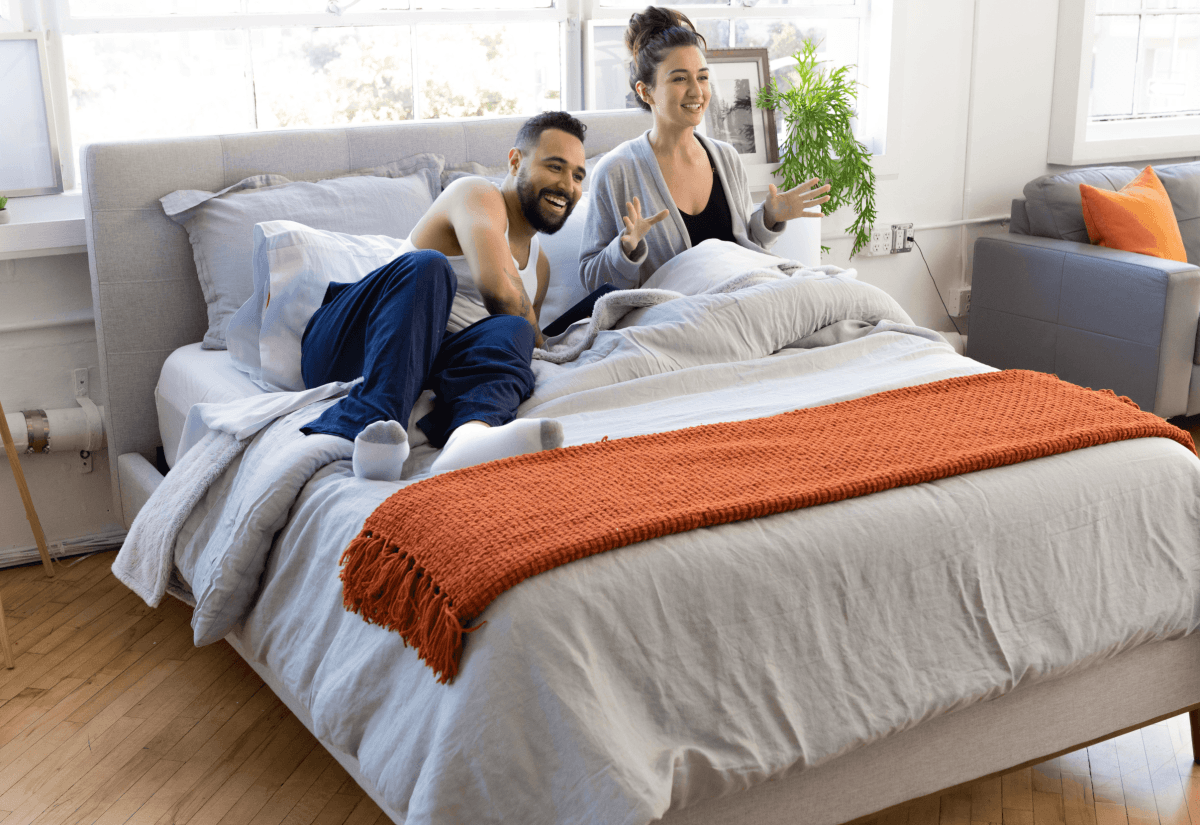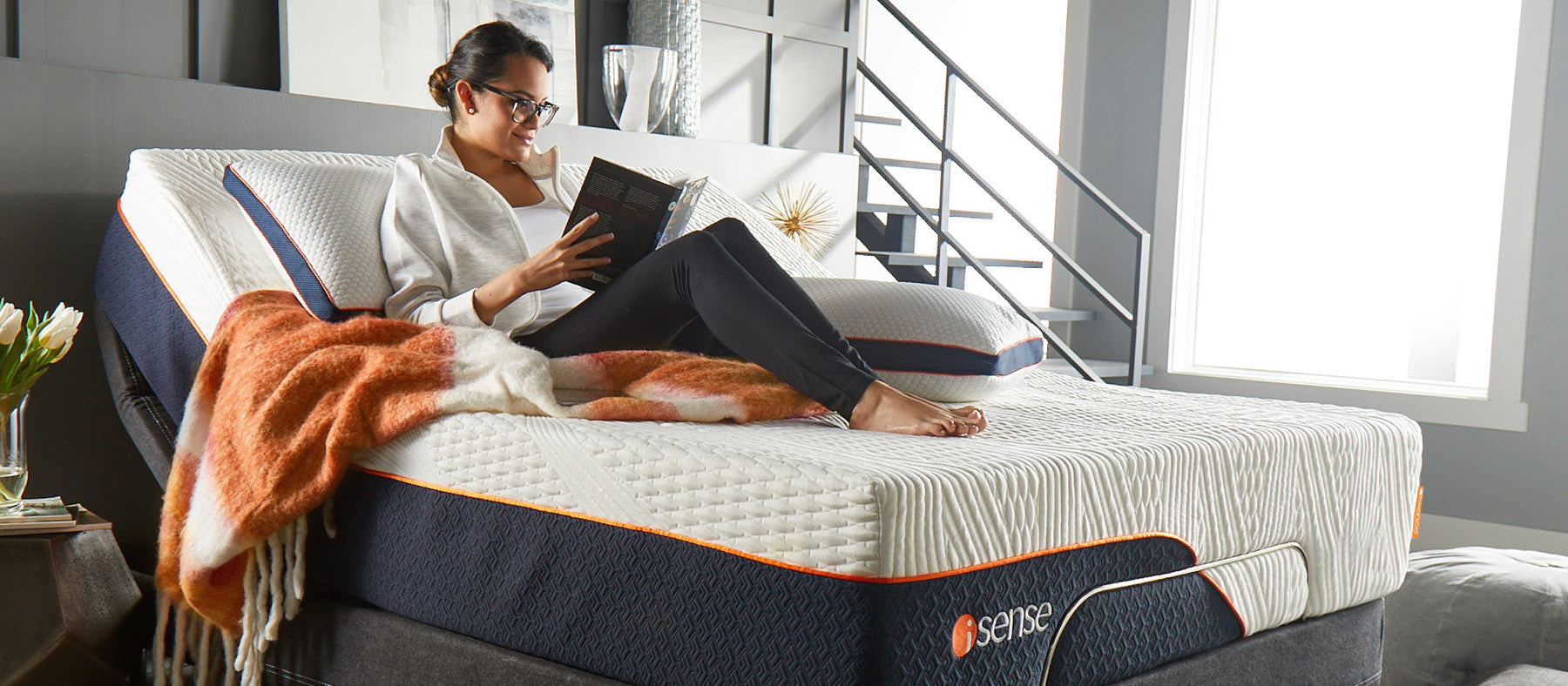As a couple in search of a new mattress, you and your partner have probably had countless conversations about your different comfort preferences based on how firm or plush a mattress feels to each of you. One partner may crave a plush bed to sink into at the end of the day, while the other thinks a firm surface that relieves pressure points is the key to lasting comfort. Neither of you are wrong about what feels good, but it turns out the comfort debate isn’t going to help you find the perfect mattress for your best night’s sleep.
Many of us tend to measure comfort in pretty simple terms—if it feels good, it’s comfortable. That may be true with clothing, but things get a little more complicated when you’re looking for the best mattress for couples. We’ll explore the following insights about comfort and cover practical advice to help you find a bed that makes you fall in love with sleep again:
- Comfort Is Personal (and Very Subjective)
- Comfort Changes Over Time
- Comfort Does Not Equal Proper Spinal Alignment
Choosing the Best Mattress for Couples: What You Need to Know About Comfort
Choosing a bed that feels good is not necessarily wrong, but there’s more to finding the right mattress for couples than buying what’s comfortable during your 10-minute showroom test run, and we’re here to tell you all about it.
1. Comfort Is Personal (and Very Subjective)
What feels good to you won’t necessarily feel good to your partner. We’re all different, with different body types, physical conditions, and perceptions. Comfort is each body’s unique perception of its environment. So naturally, how you feel sleeping on a mattress will be different from how your partner feels. With this in mind, the best mattress for couples with different preferences—which is most couples—needs to be adjustable and offer dual comfort control.
Easy Adjustability: A research report from Duke University and RTI International found that sleep quality is based on restfulness and how peacefully you sleep, not how comfortable you are during the average10-minute mattress showroom shopping experience. In fact, they were surprised to learn that you’re more likely to get a restful night’s sleep from a random mattress than one you picked out in the showroom. The solution? Couples need to be able to adjust their mattress to their real-life needs once they’ve taken it home and slept on it for a while. This feature makes isense mattresses unique and the best mattress for couples.
Dual comfort control: You and your partner have different sleep needs, so you’ve got to be able to adjust each side of the bed independently. No compromising. We recommend dual-control mattresses—AKA split mattresses for couples—so that you and your partner can share a bed together without either of your giving up your comfort or quality of sleep. You’ll both enjoy intimacy, personalized comfort and a restful night’s sleep—win, win, win.
2. Comfort Changes Over Time
If you’ve made a long-term commitment in your relationship, you already know that you and your partner will change and grow as individuals—that’s human nature. Most mattresses are built to last for 10 years, so they’re a long-term commitment, too. Over time, you and your partner’s standards of comfort change as your bodies change, which can make finding a great mattress for couples more difficult if you’re shopping based solely on how a mattress feels. This is another reason adjustability is such an important feature in a sleep system—for couples and individuals. It helps you get the most out of your investment without asking you to compromise comfort and sleep quality along the way.
What’s more, mattresses also change as you sleep on them. Just like a favorite chair will eventually wear unevenly, conventional mattresses degrade and can change shape. A bed that started out medium firm will eventually be medium or even just plush with age. That’s why a mattress can feel really comfortable at the store and for the first night but may become very uncomfortable after some time has passed. All mattresses go through changes the longer you have them, which is why isense mattresses are modular, meaning they come in a zippered case so each component can easily be replaced if needed. That, coupled with adjustability, greatly extends the life of the mattress.
3. Comfort Does Not Equal Proper Spinal Alignment
It can be hard to admit, but feeling comfortable in the moment is not always the most accurate gauge of health. You’ve likely experienced this at various points in your life and relationship, and it’s especially true of sleep health. Ultimately, the best mattress for couples will give you and your partner lasting comfort and restful sleep. However, you don’t want to confuse momentary relief of pressure points with long-term spinal alignment—an important ingredient in a great night’s sleep.
You read that right. Relief of pressure points does not equal spinal alignment, no matter how much marketers try to convince us that relieving pressure points will make us comfortable. A soft bed will relieve pain points where your body pushes into the mattress, but it tends also to leave the spine curved, which is out of alignment. That’s how a bed can feel amazing in a showroom and leave you in pain once you’ve slept on it.
When you lie on your new mattress, you and your partner can check each other’s spinal alignment and adjust—if you have an adjustable bed—to make sure your spine and the rest of your body is getting the right support where you need it. Keep reading to learn how.
How to Tell If Your Spine Is in Alignment
When your spine is properly aligned, your body creates a long line from the top of your head to the end of your tailbone, with each section of your body stacked one on top of the other. Alignment feels balanced and centered and promotes a free range of motion for the whole body. Sitting, standing and sleeping with your spine aligned might feel strange at first as you become mindful of your posture and movements in a new way.
Misalignment of your spine can lead to ongoing pain and affect your sleep quality in very negative ways. If you suffer from chronic back and joint pain or headaches, you might be experiencing some of the many symptoms that come with misalignment. And chances are, if you’re sleeping on a mattress that doesn’t properly support your spine, so is your partner. As you shop for the best mattress for married couples, set aside some time to find out whether your spines are in alignment with these two easy methods.
Method 1 (for back sleepers): When you lie on your back, have your partner look to see if there is a gap between your back and the mattress. Can you slip your hand in between the two? If so, your spine isn’t getting the support it needs. You should feel the mattress pressing gently into the small of your back. Conversely, if you can feel your body sinking into an overly plush mattress and folding forward or arching upward with too much “support,” your spine is also out of alignment and you’ll wake up with a sore back. The mattress should meet the contour of your back and hips without being so plush that it limits your range of motion.
Method 2 (for side sleepers): Lie on your side and have your partner check to see if they could draw a straight line down the center of your body from the base of your head to the hip area. If your head is too high, or too low, your pillow may be improperly supporting your upper torso, neck and head alignment. If your hips are “sinking in” too much, causing a bend in your spine from the mid to low back, you’re not getting the proper spinal alignment in the center section of your body, which will lead to a stiff and sore lower back, as well as hip distress.
Keep in mind that your pillow covers 20 percent of your sleep surface and supports your head and neck. If your pillow is the wrong loft (height), your spine won’t be properly aligned. isense founder and CEO, Paul Longman, is such a believer that adjustability is essential to a better night’s sleep that he designed an adjustable pillow that aligns your head with your spine. Whichever pillows you and your partner sleep on tonight, be sure they don’t put your head at an odd angle because that will keep you from getting the right alignment, even if you have the right bed.
Now that you know the truth about comfort and how to detect proper spinal alignment, you will be able to tell when your mattress gives you the right kind of support, and not just whether it’s firm or plush. And as your bodies change, use your spine as the arrow pointing you toward a healthier, more restful night’s sleep. The more you and your partner listen to your bodies and adjust for better alignment and rest, the better sleep and overall health you’ll experience. And yes, you’ll feel more comfortable, too!






















